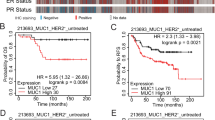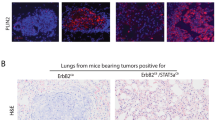Abstract
MUC1 is a transmembrane mucin that was initially cloned from malignant mammary epithelial cells as a tumor antigen. More than 90% of human breast carcinomas overexpress MUC1. Numerous studies have demonstrated an interaction between MUC1 and other oncogenic proteins such as β-catenin, erbB receptors and c-Src, but a functional role for MUC1 in transformation has not been identified. We previously reported the development of transgenic mice that overexpress human MUC1 in the mouse mammary gland (MMTV-MUC1). Analysis of these transgenic mice at an early age demonstrated the ability of MUC1 to potentiate EGF-dependent activation of MAP kinase signaling pathways in the lactating mammary gland. We now report that multiparous MMTV-MUC1 transgenic mice stochastically develop unifocal mammary gland carcinomas late in life. Molecular analysis of these tumors shows a tumor-specific coimmunoprecipitation between MUC1 and β-catenin. Examination of the contralateral glands in MMTV-MUC1 transgenics demonstrates that the development of frank carcinomas is accompanied by a failure of multiparous glands to undergo postlactational involution. Furthermore, uniparous MMTV-MUC1 transgenic mice display decreased postlactational apoptosis, elevated whey acidic protein expression and aberrant pErk2 activation. These findings are the first to determine that MUC1 overexpression promotes in vivo transformation of the mammary gland.
This is a preview of subscription content, access via your institution
Access options
Subscribe to this journal
Receive 50 print issues and online access
$259.00 per year
only $5.18 per issue
Buy this article
- Purchase on Springer Link
- Instant access to full article PDF
Prices may be subject to local taxes which are calculated during checkout










Similar content being viewed by others
References
Burdon T, Sankaran L, Wall RJ, Spencer M and Hennighausen L . (1991). J. Biol. Chem., 266, 6909–6914.
Flury N, Eppenberger U and Mueller H . (1997). Eur. J. Biochem., 249, 421–426.
Garrity MM, Burgart LJ, Riehle DL, Hill EM, Sebo TJ and Witzig T . (2003). Mod. Pathol., 16, 389–394.
Gendler SJ, Burchell JM, Duhig T, Lamport D, White R, Parker M and Taylor-Papadimitriou J . (1987). Proc. Natl. Acad. Sci. USA, 84, 6060–6064.
Gendler SJ, Lancaster CA, Taylor-Papadimitriou J, Duhig T, Peat N, Burchell J, Pemberton L, Lalani E-N and Wilson D . (1990). J. Biol. Chem., 265, 15286–15293.
Girling A, Bartkova J, Burchell J, Gendler S, Gillett C and Taylor-Papadimitriou J . (1989). Int. J. Cancer, 43, 1072–1076.
Grant S, Qiao L and Dent P . (2002). Front. Biosci., 7, d376–d389.
Huang L, Ren J, Chen D, Li Y, Kharbanda S and Kufe D . (2003). Cancer Biol. Ther., 2, 702–706.
Kolch W . (2000). Biochem. J., 351 (Part 2), 289–305.
Lan MS, Batra SK, Qi WN, Metzgar RS and Hollingsworth MA . (1990). J. Biol. Chem., 265, 15294–15299.
Li Y, Bharti A, Chen D, Gong J and Kufe D . (1998). Mol. Cell. Biol., 18, 7216–7224.
Li Y, Chen W, Ren J, Yu WH, Li Q, Yoshida K and Kufe D . (2003a). Cancer Biol. Ther., 2, 187–193.
Li Y and Kufe D . (2001). Biochem. Biophys. Res. Commun., 281, 440–443.
Li Y, Kuwahara H, Ren J, Wen G and Kufe D . (2001a). J. Biol. Chem., 276, 6061–6064.
Li Y, Liu D, Chen D, Kharbanda S and Kufe D . (2003b). Oncogene, 22, 6107–6110.
Li Y, Ren J, Yu W, Li Q, Kuwahara H, Yin L, Carraway III KL and Kufe D . (2001b). J. Biol. Chem., 276, 35239–35242.
Ligtenberg MJ, Vos HL, Gennissen AM and Hilkens J . (1990). J. Biol. Chem., 265, 5573–5578.
Mahler JF, Stokes W, Mann PC, Takaoka M and Maronpot RR . (1996). Toxicol. Pathol., 24, 710–716.
Marti A, Lazar H, Ritter P and Jaggi R . (1999). J. Mammary Gland Biol. Neoplasia, 4, 145–152.
Meerzaman D, Shapiro PS and Kim KC . (2001). Am. J. Physiol. Lung Cell Mol. Physiol., 281, L86–L91.
Mueller H, Flury N, Eppenberger-Castori S, Kueng W, David F and Eppenberger U . (2000). Int. J. Cancer, 89, 384–388.
Pandey P, Kharbanda S and Kufe D . (1995). Cancer Res., 55, 4000–4003.
Ren J, Li Y and Kufe D . (2002). J. Biol. Chem., 277, 17616–17622.
Schroeder JA, Adriance MC, Thompson MC, Camenisch TD and Gendler SJ . (2003). Oncogene, 22, 1324–1332.
Schroeder JA, Thompson MC, Gardner MM and Gendler SJ . (2001). J. Biol. Chem., 22, 22.
Sivaraman VS, Wang H, Nuovo GJ and Malbon CC . (1997). J. Clin. Invest., 99, 1478–1483.
Spicer AP, Duhig T, Chilton BS and Gendler SJ . (1995a). Mammary Genome, 6, 885–888.
Spicer AP, Rowse GJ, Lidner TK and Gendler SJ . (1995b). J. Biol. Chem., 270, 30093–30101.
Strange R, Metcalfe T, Thackray L and Dang M . (2001). Microsc. Res. Technol., 52, 171–181.
Walker NI, Bennett RE and Kerr JF . (1989). Am. J. Anat., 185, 19–32.
Wen Y, Caffrey TC, Wheelock MJ, Johnson KR and Hollingsworth MA . (2003). J. Biol. Chem., 278, 38029–38039.
Wreschner DH, Hareuveni M, Tsarfaty I, Smorodinsky N, Horev J, Zaretsky J, Kotkes P, Weiss M, Lathe R, Dion A and Keydar I . (1990). Eur. J. Biochem., 189, 463–473.
Yamamoto M, Bharti A, Li Y and Kufe D . (1997). J. Biol. Chem., 272, 12492–12494.
Yan Y, Haas JP, Kim M, Sgagias MK and Cowan KH . (2002). J. Biol. Chem., 277, 33422–33430.
Zotter S, Hageman PC, Lossnitzer A, Mooi WJ and Hilgers J . (1988). Cancer Rev., 11–12, 55–101.
Acknowledgements
We are grateful to Dr J Taylor-Papadimitriou for the HMFG-2 antibody and Biomira Inc. for the B27.29 antibody. We thank Dr Robert Cardiff and Dr Thomas Lidner for pathological analysis. We also thank Suresh Savarirayan and the animal care attendants for excellent animal care, Marvin H Ruona for computer graphics and Carol Williams for assistance with manuscript. This work was supported by NIH RO1CA64389 (SJG), NIH F32CA81703 (JAS), DOD Breast Cancer Research Program DAMD17-02-1-0476 (AAM) and Mayo Clinic College of Medicine.
Author information
Authors and Affiliations
Corresponding author
Rights and permissions
About this article
Cite this article
Schroeder, J., Masri, A., Adriance, M. et al. MUC1 overexpression results in mammary gland tumorigenesis and prolonged alveolar differentiation. Oncogene 23, 5739–5747 (2004). https://doi.org/10.1038/sj.onc.1207713
Received:
Revised:
Accepted:
Published:
Issue Date:
DOI: https://doi.org/10.1038/sj.onc.1207713
Keywords
This article is cited by
-
MUC1 triggers lineage plasticity of Her2 positive mammary tumors
Oncogene (2022)
-
Overexpression of syndecan-1, MUC-1, and putative stem cell markers in breast cancer leptomeningeal metastasis: a cerebrospinal fluid flow cytometry study
Breast Cancer Research (2017)
-
The aspirin metabolite salicylate inhibits lysine acetyltransferases and MUC1 induced epithelial to mesenchymal transition
Scientific Reports (2017)
-
Role of integrin-linked kinase in regulating the protein stability of the MUC1-C oncoprotein in pancreatic cancer cells
Oncogenesis (2017)
-
Genetically engineered mucin mouse models for inflammation and cancer
Cancer and Metastasis Reviews (2015)



